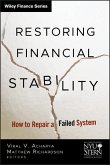Douglas J. Lucas, Laurie S. Goodman, Frank J. Fabozzi
Collateralized Debt Obligations
Structures and Analysis
Douglas J. Lucas, Laurie S. Goodman, Frank J. Fabozzi
Collateralized Debt Obligations
Structures and Analysis
- Gebundenes Buch
- Merkliste
- Auf die Merkliste
- Bewerten Bewerten
- Teilen
- Produkt teilen
- Produkterinnerung
- Produkterinnerung
Collateralized Debt Obligations, Second Edition provides updated coverage of this exciting and profitable market and describes the various products in the collateral debt obligation area, from cash flow CDOs and market value CDOs to synthetic CDOs. The authors provide new information on the building block approach to defining CDOs as well as fresh insights on European bank loans, and the U.S. high-yield loan market.
Since the publication of the first edition of Collateralized Debt Obligations, the CDO market has seen tremendous growth. In fact, as of 2005, $1.1 trillion of CDOs were…mehr
Andere Kunden interessierten sich auch für
![Collateralized Mortgage Obligations Collateralized Mortgage Obligations]() Frank J. FabozziCollateralized Mortgage Obligations91,99 €
Frank J. FabozziCollateralized Mortgage Obligations91,99 €![Managing a Corporate Bond Portfolio Managing a Corporate Bond Portfolio]() Leland E. CrabbeManaging a Corporate Bond Portfolio91,99 €
Leland E. CrabbeManaging a Corporate Bond Portfolio91,99 €![Das 1-Faktor-Copula-Modell: Bewertung von synthetischen Collateralized Debt Obligations Das 1-Faktor-Copula-Modell: Bewertung von synthetischen Collateralized Debt Obligations]() Jonas KoeglerDas 1-Faktor-Copula-Modell: Bewertung von synthetischen Collateralized Debt Obligations44,99 €
Jonas KoeglerDas 1-Faktor-Copula-Modell: Bewertung von synthetischen Collateralized Debt Obligations44,99 €![Loan Workouts and Debt for Equity Swaps Loan Workouts and Debt for Equity Swaps]() Subhrendu ChatterjiLoan Workouts and Debt for Equity Swaps216,99 €
Subhrendu ChatterjiLoan Workouts and Debt for Equity Swaps216,99 €![The Rating Agencies and Their Credit Ratings The Rating Agencies and Their Credit Ratings]() Herwig LangohrThe Rating Agencies and Their Credit Ratings109,99 €
Herwig LangohrThe Rating Agencies and Their Credit Ratings109,99 €![Restoring Financial Stability Restoring Financial Stability]() New York University Stern School of BusinessRestoring Financial Stability42,99 €
New York University Stern School of BusinessRestoring Financial Stability42,99 €![How to Create and Manage a Hedge Fund How to Create and Manage a Hedge Fund]() Stuart A. McCraryHow to Create and Manage a Hedge Fund108,99 €
Stuart A. McCraryHow to Create and Manage a Hedge Fund108,99 €-
-
-
Collateralized Debt Obligations, Second Edition provides updated coverage of this exciting and profitable market and describes the various products in the collateral debt obligation area, from cash flow CDOs and market value CDOs to synthetic CDOs. The authors provide new information on the building block approach to defining CDOs as well as fresh insights on European bank loans, and the U.S. high-yield loan market.
Since the publication of the first edition of Collateralized Debt Obligations, the CDO market has seen tremendous growth. In fact, as of 2005, $1.1 trillion of CDOs were outstanding-making them the fastest-growing investment vehicle of the last decade.
To help you keep up with the expanding CDO market and its various instruments, Douglas Lucas, Laurie Goodman, and Frank Fabozzi have collaborated to bring you a fully revised and up-to-date Second Edition of Collateralized Debt Obligations. Written in a clear and accessible style, this book is a valuable guide that provides you with critical information regarding the evolving nature of the CDO market.
Filled with in-depth insights gleaned from years of investment and credit experience, Collateralized Debt Obligations, Second Edition examines a wide range of issues, including:
_ Cash CDOs
_ Loans and CLOs
_ Structured finance CDOs and collateral review
_ Emerging market and market value CDOs
_ Synthetic CDOs
CDOs offer exciting opportunities for those who understand their complexities. With Collateralized Debt Obligations, Second Edition as your guide, you can begin to understand and take advantage of this dynamic market and its products.
Since the publication of the first edition of Collateralized Debt Obligations, the CDO market has seen tremendous growth. In fact, as of 2005, $1.1 trillion of CDOs were outstanding-making them the fastest-growing investment vehicle of the last decade.
To help you keep up with the expanding CDO market and its various instruments, Douglas Lucas, Laurie Goodman, and Frank Fabozzi have collaborated to bring you a fully revised and up-to-date Second Edition of Collateralized Debt Obligations. Written in a clear and accessible style, this book is a valuable guide that provides you with critical information regarding the evolving nature of the CDO market.
Filled with in-depth insights gleaned from years of investment and credit experience, Collateralized Debt Obligations, Second Edition examines a wide range of issues, including:
_ Cash CDOs
_ Loans and CLOs
_ Structured finance CDOs and collateral review
_ Emerging market and market value CDOs
_ Synthetic CDOs
CDOs offer exciting opportunities for those who understand their complexities. With Collateralized Debt Obligations, Second Edition as your guide, you can begin to understand and take advantage of this dynamic market and its products.
Produktdetails
- Produktdetails
- Frank J. Fabozzi Series
- Verlag: Wiley & Sons
- 2. Aufl.
- Seitenzahl: 528
- Erscheinungstermin: 1. März 2006
- Englisch
- Abmessung: 235mm x 157mm x 33mm
- Gewicht: 750g
- ISBN-13: 9780471718871
- ISBN-10: 0471718874
- Artikelnr.: 20834040
- Herstellerkennzeichnung
- Libri GmbH
- Europaallee 1
- 36244 Bad Hersfeld
- gpsr@libri.de
- Frank J. Fabozzi Series
- Verlag: Wiley & Sons
- 2. Aufl.
- Seitenzahl: 528
- Erscheinungstermin: 1. März 2006
- Englisch
- Abmessung: 235mm x 157mm x 33mm
- Gewicht: 750g
- ISBN-13: 9780471718871
- ISBN-10: 0471718874
- Artikelnr.: 20834040
- Herstellerkennzeichnung
- Libri GmbH
- Europaallee 1
- 36244 Bad Hersfeld
- gpsr@libri.de
DOUGLAS J. LUCAS is Executive Director and Head of CDO Research at UBS. He is also Chairman of The Bond Market Association's CDO Research Committee and ranked top three in CDO research in the Institutional Investor's fixed income analyst survey. Lucas has been involved in the CDO market for nearly two decades, having developed Moody's rating methodology for CDOs in 1989. LAURIE S. GOODMAN, PHD, is Managing Director and co-Head of Global Fixed Income Research at UBS. She manages U.S. Securitized Products and Treasury/Agency/Derivatives Research. Goodman has worked on Wall Street for over twenty years and is well regarded by the investor community, having won more #1 slots on the Institutional Investor All-American Fixed Income Team than any other analyst. FRANK J. FABOZZI, PHD, CFA, CPA, is an Adjunct Professor of Finance and Becton Fellow at Yale University's School of Management and a Fellow of the International Center for Finance. Fabozzi is the Editor of the Journal of Portfolio Management.
Preface xiii
About the Authors xxi
Part One Introduction to Cash CDOs 1
Chapter 1 Cash CDO Basics 3
Why Study CDOs? 3
Understanding CDOs 4
Credit Structures 10
A CDO Structural Matrix 13
CDOs Being Offered Today 14
Parties to a CDO 14
Chapter 2 Cash Flow CDOs 17
Distribution of Cash Flows 17
Restrictions on Management: Safety Nets 20
Credit Ratings 23
Call Provisions in CDO Transactions 38
Part Two Loans and CLOs 41
Chapter 3 High-Yield Loans: Structure and Performance 43
The Loan Market 44
The Syndication Process 46
Loan Structure and Leaders 48
Loan Interest Rates and Upfront Fees 49
Loan Credit Quality 51
Lender's Liability 52
Overview of Loan Terms 53
Loan Terms versus Bond Terms 58
A Tale of Two Loans 58
The Secondary Market 60
Loan Recovery Rates 61
Loan Default Rates 63
High-Yield Loan CLO versus High-Yield Bond CBO Performance 67
Conclusion 74
Chapter 4 European Bank Loans and Middle Market Loans 75
European Bank Loans 75
Middle Market Loans 91
Conclusion 99
Part Three Structured Finance CDOs and Collateral Review 101
Chapter 5 Review of Structured Finance Collateral: Mortgage-Related
Products 103
Residential Mortgage-Backed Securities 103
Commercial Mortgage-Backed Securities 125
Real Estate Investment Trust Debt 129
Chapter 6 Review of Structured Finance Collateral: Nonmortgage ABS 135
Credit Card Receivable-Backed Securities 135
Auto Loan-Backed Securities 137
Student Loan-Backed Securities 139
SBA Loan-Backed Securities 141
Aircraft Lease-Backed Securities 142
Franchise Loan-Backed Securities 145
Rate Reduction Bonds 148
Chapter 7 Structured Finance Default and Recovery Rates 153
Structured Finance versus Corporate Default Rates 154
S&P Rating Transition Studies and the Matrix Multiplying Approach 156
Results of Multiplying S&P Rating Transition Matrices 158
S&P on Structured Finance Loss Given Default 159
S&P Constant Annual Default and Recoveries 159
Moody's Material Impairment Study 160
Comparing and Reconciling Structured Finance Default Rates 162
Moody's on Structured Finance Historical Loss Rates 164
Moody's Constant Annual Default and Recoveries 166
Blending S&P and Moody's Studies 167
Applying CDRs and Recoveries to SF CDOs 167
Conclusion 170
Chapter 8 Structured Finance Cash Flow CDOs 171
SF CDOs versus High-Yield CDOs 172
Rating Agencies on Structured Finance CDOs 174
Structured Finance Assets' Negative Convexity 182
Extension Risk 183
Conclusion 185
Part Four Other Types of Cash CDOs 187
Chapter 9 Emerging Market CDOs 189
EM Sovereign Bond Defaults 190
Why the Better Track Record? 192
CDO Rating Differences: EM versus High Yield 193
Conclusion 198
Chapter 10 Market Value CDOs 201
Cash Flow versus Market Value Deals 201
The Rating Process 202
How Advance Rates are Derived 212
Conclusion 215
Part Five Synthetic CDOs 217
Chapter 11 Introduction to Credit Default Swaps and Synthetic CDOs 219
Credit Default Swaps 219
Synthetic CDOs 229
Conclusion 239
Chapter 12 Synthetic Balance Sheet CDOs 241
Cash CLOs for Balance Sheet Management 241
Partially Funded Synthetic CDOs 249
Conclusion 253
Chapter 13 Synthetic Arbitrage CDOs 255
Full Capital Structure Synthetic Arbitrage CDOs 256
Single-Tranche CDOs 260
Standard Tranches of CDS Indices 261
Conclusion 262
Chapter 14 A Framework for Evaluating Trades in the Credit Derivatives
Market 265
Assessing Single-Name and CDO Tranched Exposures 266
Assessing CDO Equity versus a Basket Swap 274
Conclusion 280
Chapter 15 Structured Finance Credit Default Swaps and Synthetic CDOs 281
Differences between Corporate and Structured Finance Credit 282
Difficulties in SF CDS 284
SF CDS Effect on SF CDO Management 294
Two New Types of SF CDOs 295
Effects of SF CDS on CDO Credit Quality and Spreads 296
Conclusion 297
Part Six Default Correlation 299
Chapter 16 Default Correlation: The Basics 301
Default Correlation Defined 301
Default Probability and Default Correlation 305
Conclusion 321
Chapter 17 Empirical Default Correlations: Problems and Solutions 323
Empirical Results 323
Problems with Historical Default Correlations 327
Proposed Solutions 330
Conclusion 344
Part Seven CDO Equity 345
Chapter 18 Why Buy CDO Equity? 347
Nonrecourse Term Financing 347
The Forgiving Nature of CDO Financing 354
CDO Options 356
CDO Equity as a Defensive Strategy 359
Conclusion 360
Chapter 19 CDO Equity Returns and Return Correlation 361
Flawed Methodologies 362
The Appropriate Lesson from History 365
Loan Defaults and Recoveries 367
Cash Flow Modeling Defaults and Recoveries 370
Structured Finance Defaults and Recoveries 371
SF CDO Cash Flow Modeling 372
Return Correlation and Nonrecourse Leverage 374
Conclusion 378
Part Eight Other CDO Topics 379
Chapter 20 Analytical Challenges in Secondary CDO Market Trading 381
Important Developments: Spread Tightening, Increased Activity 382
Pitfalls in Secondary CDO Trading 384
Eight-Point Checklist in Evaluating a CDO in the Secondary Market 387
Prescription for Making Primary Issuances Conducive to Secondary Trading
408
Conclusion 409
Chapter 21 The CDO Arbitrage 411
Building Blocks 411
Impact of CDO Arbitrage on Structure 422
Conclusion 425
Chapter 22 How to Evaluate a CDO and Manage a CDO Portfolio 427
Incentive Clashes in CDO Structures 427
Evaluate Structural Enhancements 428
Evaluating the Manager's Track Record 429
Conclusion 434
Chapter 23 Quantifying Single-Name Risk Across CDOs 435
Collateral Overlap in U.S. CLOs 436
Favorite CLO Credits 437
Collateral Overlap in U.S. Structured Finance CDOs 439
Single-Name Risk and Tranche Protections 441
Excess Overcollateralization and Excess Overcollateralization Delta 443
Monte Carlo Simulation of Single Credit Risk 446
Comparing the Two Approaches 449
Conclusion 450
Chapter 24 CDO Rating Experience 453
CDO Rating Downgrade Data 454
CDO and Tranche Rating Downgrade Frequency 456
CDO Downgrade Patterns 458
Why Downgrade Patterns? 460
Downgrade Severity 462
Downgrades of Aaa CDO Tranches 464
Extreme Rating Downgrades 464
CDO Defaults and Near Defaults 469
Conclusion 473
Index 477
About the Authors xxi
Part One Introduction to Cash CDOs 1
Chapter 1 Cash CDO Basics 3
Why Study CDOs? 3
Understanding CDOs 4
Credit Structures 10
A CDO Structural Matrix 13
CDOs Being Offered Today 14
Parties to a CDO 14
Chapter 2 Cash Flow CDOs 17
Distribution of Cash Flows 17
Restrictions on Management: Safety Nets 20
Credit Ratings 23
Call Provisions in CDO Transactions 38
Part Two Loans and CLOs 41
Chapter 3 High-Yield Loans: Structure and Performance 43
The Loan Market 44
The Syndication Process 46
Loan Structure and Leaders 48
Loan Interest Rates and Upfront Fees 49
Loan Credit Quality 51
Lender's Liability 52
Overview of Loan Terms 53
Loan Terms versus Bond Terms 58
A Tale of Two Loans 58
The Secondary Market 60
Loan Recovery Rates 61
Loan Default Rates 63
High-Yield Loan CLO versus High-Yield Bond CBO Performance 67
Conclusion 74
Chapter 4 European Bank Loans and Middle Market Loans 75
European Bank Loans 75
Middle Market Loans 91
Conclusion 99
Part Three Structured Finance CDOs and Collateral Review 101
Chapter 5 Review of Structured Finance Collateral: Mortgage-Related
Products 103
Residential Mortgage-Backed Securities 103
Commercial Mortgage-Backed Securities 125
Real Estate Investment Trust Debt 129
Chapter 6 Review of Structured Finance Collateral: Nonmortgage ABS 135
Credit Card Receivable-Backed Securities 135
Auto Loan-Backed Securities 137
Student Loan-Backed Securities 139
SBA Loan-Backed Securities 141
Aircraft Lease-Backed Securities 142
Franchise Loan-Backed Securities 145
Rate Reduction Bonds 148
Chapter 7 Structured Finance Default and Recovery Rates 153
Structured Finance versus Corporate Default Rates 154
S&P Rating Transition Studies and the Matrix Multiplying Approach 156
Results of Multiplying S&P Rating Transition Matrices 158
S&P on Structured Finance Loss Given Default 159
S&P Constant Annual Default and Recoveries 159
Moody's Material Impairment Study 160
Comparing and Reconciling Structured Finance Default Rates 162
Moody's on Structured Finance Historical Loss Rates 164
Moody's Constant Annual Default and Recoveries 166
Blending S&P and Moody's Studies 167
Applying CDRs and Recoveries to SF CDOs 167
Conclusion 170
Chapter 8 Structured Finance Cash Flow CDOs 171
SF CDOs versus High-Yield CDOs 172
Rating Agencies on Structured Finance CDOs 174
Structured Finance Assets' Negative Convexity 182
Extension Risk 183
Conclusion 185
Part Four Other Types of Cash CDOs 187
Chapter 9 Emerging Market CDOs 189
EM Sovereign Bond Defaults 190
Why the Better Track Record? 192
CDO Rating Differences: EM versus High Yield 193
Conclusion 198
Chapter 10 Market Value CDOs 201
Cash Flow versus Market Value Deals 201
The Rating Process 202
How Advance Rates are Derived 212
Conclusion 215
Part Five Synthetic CDOs 217
Chapter 11 Introduction to Credit Default Swaps and Synthetic CDOs 219
Credit Default Swaps 219
Synthetic CDOs 229
Conclusion 239
Chapter 12 Synthetic Balance Sheet CDOs 241
Cash CLOs for Balance Sheet Management 241
Partially Funded Synthetic CDOs 249
Conclusion 253
Chapter 13 Synthetic Arbitrage CDOs 255
Full Capital Structure Synthetic Arbitrage CDOs 256
Single-Tranche CDOs 260
Standard Tranches of CDS Indices 261
Conclusion 262
Chapter 14 A Framework for Evaluating Trades in the Credit Derivatives
Market 265
Assessing Single-Name and CDO Tranched Exposures 266
Assessing CDO Equity versus a Basket Swap 274
Conclusion 280
Chapter 15 Structured Finance Credit Default Swaps and Synthetic CDOs 281
Differences between Corporate and Structured Finance Credit 282
Difficulties in SF CDS 284
SF CDS Effect on SF CDO Management 294
Two New Types of SF CDOs 295
Effects of SF CDS on CDO Credit Quality and Spreads 296
Conclusion 297
Part Six Default Correlation 299
Chapter 16 Default Correlation: The Basics 301
Default Correlation Defined 301
Default Probability and Default Correlation 305
Conclusion 321
Chapter 17 Empirical Default Correlations: Problems and Solutions 323
Empirical Results 323
Problems with Historical Default Correlations 327
Proposed Solutions 330
Conclusion 344
Part Seven CDO Equity 345
Chapter 18 Why Buy CDO Equity? 347
Nonrecourse Term Financing 347
The Forgiving Nature of CDO Financing 354
CDO Options 356
CDO Equity as a Defensive Strategy 359
Conclusion 360
Chapter 19 CDO Equity Returns and Return Correlation 361
Flawed Methodologies 362
The Appropriate Lesson from History 365
Loan Defaults and Recoveries 367
Cash Flow Modeling Defaults and Recoveries 370
Structured Finance Defaults and Recoveries 371
SF CDO Cash Flow Modeling 372
Return Correlation and Nonrecourse Leverage 374
Conclusion 378
Part Eight Other CDO Topics 379
Chapter 20 Analytical Challenges in Secondary CDO Market Trading 381
Important Developments: Spread Tightening, Increased Activity 382
Pitfalls in Secondary CDO Trading 384
Eight-Point Checklist in Evaluating a CDO in the Secondary Market 387
Prescription for Making Primary Issuances Conducive to Secondary Trading
408
Conclusion 409
Chapter 21 The CDO Arbitrage 411
Building Blocks 411
Impact of CDO Arbitrage on Structure 422
Conclusion 425
Chapter 22 How to Evaluate a CDO and Manage a CDO Portfolio 427
Incentive Clashes in CDO Structures 427
Evaluate Structural Enhancements 428
Evaluating the Manager's Track Record 429
Conclusion 434
Chapter 23 Quantifying Single-Name Risk Across CDOs 435
Collateral Overlap in U.S. CLOs 436
Favorite CLO Credits 437
Collateral Overlap in U.S. Structured Finance CDOs 439
Single-Name Risk and Tranche Protections 441
Excess Overcollateralization and Excess Overcollateralization Delta 443
Monte Carlo Simulation of Single Credit Risk 446
Comparing the Two Approaches 449
Conclusion 450
Chapter 24 CDO Rating Experience 453
CDO Rating Downgrade Data 454
CDO and Tranche Rating Downgrade Frequency 456
CDO Downgrade Patterns 458
Why Downgrade Patterns? 460
Downgrade Severity 462
Downgrades of Aaa CDO Tranches 464
Extreme Rating Downgrades 464
CDO Defaults and Near Defaults 469
Conclusion 473
Index 477
Preface xiii
About the Authors xxi
Part One Introduction to Cash CDOs 1
Chapter 1 Cash CDO Basics 3
Why Study CDOs? 3
Understanding CDOs 4
Credit Structures 10
A CDO Structural Matrix 13
CDOs Being Offered Today 14
Parties to a CDO 14
Chapter 2 Cash Flow CDOs 17
Distribution of Cash Flows 17
Restrictions on Management: Safety Nets 20
Credit Ratings 23
Call Provisions in CDO Transactions 38
Part Two Loans and CLOs 41
Chapter 3 High-Yield Loans: Structure and Performance 43
The Loan Market 44
The Syndication Process 46
Loan Structure and Leaders 48
Loan Interest Rates and Upfront Fees 49
Loan Credit Quality 51
Lender's Liability 52
Overview of Loan Terms 53
Loan Terms versus Bond Terms 58
A Tale of Two Loans 58
The Secondary Market 60
Loan Recovery Rates 61
Loan Default Rates 63
High-Yield Loan CLO versus High-Yield Bond CBO Performance 67
Conclusion 74
Chapter 4 European Bank Loans and Middle Market Loans 75
European Bank Loans 75
Middle Market Loans 91
Conclusion 99
Part Three Structured Finance CDOs and Collateral Review 101
Chapter 5 Review of Structured Finance Collateral: Mortgage-Related
Products 103
Residential Mortgage-Backed Securities 103
Commercial Mortgage-Backed Securities 125
Real Estate Investment Trust Debt 129
Chapter 6 Review of Structured Finance Collateral: Nonmortgage ABS 135
Credit Card Receivable-Backed Securities 135
Auto Loan-Backed Securities 137
Student Loan-Backed Securities 139
SBA Loan-Backed Securities 141
Aircraft Lease-Backed Securities 142
Franchise Loan-Backed Securities 145
Rate Reduction Bonds 148
Chapter 7 Structured Finance Default and Recovery Rates 153
Structured Finance versus Corporate Default Rates 154
S&P Rating Transition Studies and the Matrix Multiplying Approach 156
Results of Multiplying S&P Rating Transition Matrices 158
S&P on Structured Finance Loss Given Default 159
S&P Constant Annual Default and Recoveries 159
Moody's Material Impairment Study 160
Comparing and Reconciling Structured Finance Default Rates 162
Moody's on Structured Finance Historical Loss Rates 164
Moody's Constant Annual Default and Recoveries 166
Blending S&P and Moody's Studies 167
Applying CDRs and Recoveries to SF CDOs 167
Conclusion 170
Chapter 8 Structured Finance Cash Flow CDOs 171
SF CDOs versus High-Yield CDOs 172
Rating Agencies on Structured Finance CDOs 174
Structured Finance Assets' Negative Convexity 182
Extension Risk 183
Conclusion 185
Part Four Other Types of Cash CDOs 187
Chapter 9 Emerging Market CDOs 189
EM Sovereign Bond Defaults 190
Why the Better Track Record? 192
CDO Rating Differences: EM versus High Yield 193
Conclusion 198
Chapter 10 Market Value CDOs 201
Cash Flow versus Market Value Deals 201
The Rating Process 202
How Advance Rates are Derived 212
Conclusion 215
Part Five Synthetic CDOs 217
Chapter 11 Introduction to Credit Default Swaps and Synthetic CDOs 219
Credit Default Swaps 219
Synthetic CDOs 229
Conclusion 239
Chapter 12 Synthetic Balance Sheet CDOs 241
Cash CLOs for Balance Sheet Management 241
Partially Funded Synthetic CDOs 249
Conclusion 253
Chapter 13 Synthetic Arbitrage CDOs 255
Full Capital Structure Synthetic Arbitrage CDOs 256
Single-Tranche CDOs 260
Standard Tranches of CDS Indices 261
Conclusion 262
Chapter 14 A Framework for Evaluating Trades in the Credit Derivatives
Market 265
Assessing Single-Name and CDO Tranched Exposures 266
Assessing CDO Equity versus a Basket Swap 274
Conclusion 280
Chapter 15 Structured Finance Credit Default Swaps and Synthetic CDOs 281
Differences between Corporate and Structured Finance Credit 282
Difficulties in SF CDS 284
SF CDS Effect on SF CDO Management 294
Two New Types of SF CDOs 295
Effects of SF CDS on CDO Credit Quality and Spreads 296
Conclusion 297
Part Six Default Correlation 299
Chapter 16 Default Correlation: The Basics 301
Default Correlation Defined 301
Default Probability and Default Correlation 305
Conclusion 321
Chapter 17 Empirical Default Correlations: Problems and Solutions 323
Empirical Results 323
Problems with Historical Default Correlations 327
Proposed Solutions 330
Conclusion 344
Part Seven CDO Equity 345
Chapter 18 Why Buy CDO Equity? 347
Nonrecourse Term Financing 347
The Forgiving Nature of CDO Financing 354
CDO Options 356
CDO Equity as a Defensive Strategy 359
Conclusion 360
Chapter 19 CDO Equity Returns and Return Correlation 361
Flawed Methodologies 362
The Appropriate Lesson from History 365
Loan Defaults and Recoveries 367
Cash Flow Modeling Defaults and Recoveries 370
Structured Finance Defaults and Recoveries 371
SF CDO Cash Flow Modeling 372
Return Correlation and Nonrecourse Leverage 374
Conclusion 378
Part Eight Other CDO Topics 379
Chapter 20 Analytical Challenges in Secondary CDO Market Trading 381
Important Developments: Spread Tightening, Increased Activity 382
Pitfalls in Secondary CDO Trading 384
Eight-Point Checklist in Evaluating a CDO in the Secondary Market 387
Prescription for Making Primary Issuances Conducive to Secondary Trading
408
Conclusion 409
Chapter 21 The CDO Arbitrage 411
Building Blocks 411
Impact of CDO Arbitrage on Structure 422
Conclusion 425
Chapter 22 How to Evaluate a CDO and Manage a CDO Portfolio 427
Incentive Clashes in CDO Structures 427
Evaluate Structural Enhancements 428
Evaluating the Manager's Track Record 429
Conclusion 434
Chapter 23 Quantifying Single-Name Risk Across CDOs 435
Collateral Overlap in U.S. CLOs 436
Favorite CLO Credits 437
Collateral Overlap in U.S. Structured Finance CDOs 439
Single-Name Risk and Tranche Protections 441
Excess Overcollateralization and Excess Overcollateralization Delta 443
Monte Carlo Simulation of Single Credit Risk 446
Comparing the Two Approaches 449
Conclusion 450
Chapter 24 CDO Rating Experience 453
CDO Rating Downgrade Data 454
CDO and Tranche Rating Downgrade Frequency 456
CDO Downgrade Patterns 458
Why Downgrade Patterns? 460
Downgrade Severity 462
Downgrades of Aaa CDO Tranches 464
Extreme Rating Downgrades 464
CDO Defaults and Near Defaults 469
Conclusion 473
Index 477
About the Authors xxi
Part One Introduction to Cash CDOs 1
Chapter 1 Cash CDO Basics 3
Why Study CDOs? 3
Understanding CDOs 4
Credit Structures 10
A CDO Structural Matrix 13
CDOs Being Offered Today 14
Parties to a CDO 14
Chapter 2 Cash Flow CDOs 17
Distribution of Cash Flows 17
Restrictions on Management: Safety Nets 20
Credit Ratings 23
Call Provisions in CDO Transactions 38
Part Two Loans and CLOs 41
Chapter 3 High-Yield Loans: Structure and Performance 43
The Loan Market 44
The Syndication Process 46
Loan Structure and Leaders 48
Loan Interest Rates and Upfront Fees 49
Loan Credit Quality 51
Lender's Liability 52
Overview of Loan Terms 53
Loan Terms versus Bond Terms 58
A Tale of Two Loans 58
The Secondary Market 60
Loan Recovery Rates 61
Loan Default Rates 63
High-Yield Loan CLO versus High-Yield Bond CBO Performance 67
Conclusion 74
Chapter 4 European Bank Loans and Middle Market Loans 75
European Bank Loans 75
Middle Market Loans 91
Conclusion 99
Part Three Structured Finance CDOs and Collateral Review 101
Chapter 5 Review of Structured Finance Collateral: Mortgage-Related
Products 103
Residential Mortgage-Backed Securities 103
Commercial Mortgage-Backed Securities 125
Real Estate Investment Trust Debt 129
Chapter 6 Review of Structured Finance Collateral: Nonmortgage ABS 135
Credit Card Receivable-Backed Securities 135
Auto Loan-Backed Securities 137
Student Loan-Backed Securities 139
SBA Loan-Backed Securities 141
Aircraft Lease-Backed Securities 142
Franchise Loan-Backed Securities 145
Rate Reduction Bonds 148
Chapter 7 Structured Finance Default and Recovery Rates 153
Structured Finance versus Corporate Default Rates 154
S&P Rating Transition Studies and the Matrix Multiplying Approach 156
Results of Multiplying S&P Rating Transition Matrices 158
S&P on Structured Finance Loss Given Default 159
S&P Constant Annual Default and Recoveries 159
Moody's Material Impairment Study 160
Comparing and Reconciling Structured Finance Default Rates 162
Moody's on Structured Finance Historical Loss Rates 164
Moody's Constant Annual Default and Recoveries 166
Blending S&P and Moody's Studies 167
Applying CDRs and Recoveries to SF CDOs 167
Conclusion 170
Chapter 8 Structured Finance Cash Flow CDOs 171
SF CDOs versus High-Yield CDOs 172
Rating Agencies on Structured Finance CDOs 174
Structured Finance Assets' Negative Convexity 182
Extension Risk 183
Conclusion 185
Part Four Other Types of Cash CDOs 187
Chapter 9 Emerging Market CDOs 189
EM Sovereign Bond Defaults 190
Why the Better Track Record? 192
CDO Rating Differences: EM versus High Yield 193
Conclusion 198
Chapter 10 Market Value CDOs 201
Cash Flow versus Market Value Deals 201
The Rating Process 202
How Advance Rates are Derived 212
Conclusion 215
Part Five Synthetic CDOs 217
Chapter 11 Introduction to Credit Default Swaps and Synthetic CDOs 219
Credit Default Swaps 219
Synthetic CDOs 229
Conclusion 239
Chapter 12 Synthetic Balance Sheet CDOs 241
Cash CLOs for Balance Sheet Management 241
Partially Funded Synthetic CDOs 249
Conclusion 253
Chapter 13 Synthetic Arbitrage CDOs 255
Full Capital Structure Synthetic Arbitrage CDOs 256
Single-Tranche CDOs 260
Standard Tranches of CDS Indices 261
Conclusion 262
Chapter 14 A Framework for Evaluating Trades in the Credit Derivatives
Market 265
Assessing Single-Name and CDO Tranched Exposures 266
Assessing CDO Equity versus a Basket Swap 274
Conclusion 280
Chapter 15 Structured Finance Credit Default Swaps and Synthetic CDOs 281
Differences between Corporate and Structured Finance Credit 282
Difficulties in SF CDS 284
SF CDS Effect on SF CDO Management 294
Two New Types of SF CDOs 295
Effects of SF CDS on CDO Credit Quality and Spreads 296
Conclusion 297
Part Six Default Correlation 299
Chapter 16 Default Correlation: The Basics 301
Default Correlation Defined 301
Default Probability and Default Correlation 305
Conclusion 321
Chapter 17 Empirical Default Correlations: Problems and Solutions 323
Empirical Results 323
Problems with Historical Default Correlations 327
Proposed Solutions 330
Conclusion 344
Part Seven CDO Equity 345
Chapter 18 Why Buy CDO Equity? 347
Nonrecourse Term Financing 347
The Forgiving Nature of CDO Financing 354
CDO Options 356
CDO Equity as a Defensive Strategy 359
Conclusion 360
Chapter 19 CDO Equity Returns and Return Correlation 361
Flawed Methodologies 362
The Appropriate Lesson from History 365
Loan Defaults and Recoveries 367
Cash Flow Modeling Defaults and Recoveries 370
Structured Finance Defaults and Recoveries 371
SF CDO Cash Flow Modeling 372
Return Correlation and Nonrecourse Leverage 374
Conclusion 378
Part Eight Other CDO Topics 379
Chapter 20 Analytical Challenges in Secondary CDO Market Trading 381
Important Developments: Spread Tightening, Increased Activity 382
Pitfalls in Secondary CDO Trading 384
Eight-Point Checklist in Evaluating a CDO in the Secondary Market 387
Prescription for Making Primary Issuances Conducive to Secondary Trading
408
Conclusion 409
Chapter 21 The CDO Arbitrage 411
Building Blocks 411
Impact of CDO Arbitrage on Structure 422
Conclusion 425
Chapter 22 How to Evaluate a CDO and Manage a CDO Portfolio 427
Incentive Clashes in CDO Structures 427
Evaluate Structural Enhancements 428
Evaluating the Manager's Track Record 429
Conclusion 434
Chapter 23 Quantifying Single-Name Risk Across CDOs 435
Collateral Overlap in U.S. CLOs 436
Favorite CLO Credits 437
Collateral Overlap in U.S. Structured Finance CDOs 439
Single-Name Risk and Tranche Protections 441
Excess Overcollateralization and Excess Overcollateralization Delta 443
Monte Carlo Simulation of Single Credit Risk 446
Comparing the Two Approaches 449
Conclusion 450
Chapter 24 CDO Rating Experience 453
CDO Rating Downgrade Data 454
CDO and Tranche Rating Downgrade Frequency 456
CDO Downgrade Patterns 458
Why Downgrade Patterns? 460
Downgrade Severity 462
Downgrades of Aaa CDO Tranches 464
Extreme Rating Downgrades 464
CDO Defaults and Near Defaults 469
Conclusion 473
Index 477








